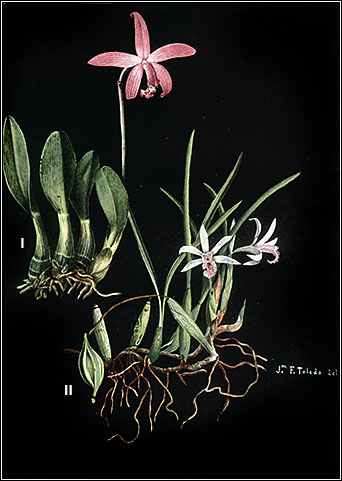Microlaelia
lundii (Rchb.f)
Chiron & V. P. Castro
There are occurrences registered to the Federal District (Brasilia)
and to the states of de Goiás, Minas Gerais, |
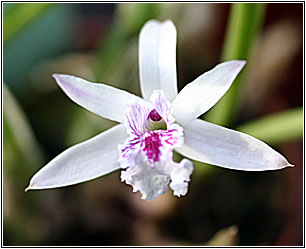 |
Mato
Grosso do Sul, Paraná and São Paulo.
In spite of not being common in the state of Minas Gerais, it
has been described from a plant collected there (Otia Botanica
Hamburgensia 2: 92), as Bletia lundii Rchb. f. &
Warm. in 1881. However, soon later, apparently in the same publication,
Reichenbach f. described it again as Laelia. In the same
year, Barbosa Rodrigues described the same species as Laelia
regnellii and published it in Genera et Species Orchidearum
Novarum 2: 154.
In l892, another description has been done under the name of
Laelia reichenbachiana H. Wendl. & Kraenzl and published
in Xenia Orchidacea 3(6): 97.
|
|
In 2000, Van den Berg & M.W. Chase proposed the transference
to the genus Sophronitis as Sophronitis lundii
(Rchb. f. & Warm.) C. Van den Berg & M.W. Chase, Lindleyana
15(2):117.
In 2002, Chiron & V. P. Castro established the genus Microlaelia
to shelter this only species [Microlaelia lundi (Rchb.f)
Chiron & V. P. Castro], published in Richardiana. II(1).24,
taking the name of the section Microlaelia, according
to the classification of the genus Laelia, adopted by
Pabst & Dungs in Orchidaceae Brasilienses, vol I, 1975.
This species grows in small trees situated in inselbergs (on
rocky outcrops)
or directly on the rocks, in shade places in gallery woods.
It blooms in winter, the small spikes bear from 1 to 3 flowers
which do not exceed 4cm diameter.
This species requires temperate climate, well ventilated place
and high humid environment and seems to need more luminosity
than found in its habitat.
In São Paulo, there is the natural hybrid, result of the cross
with Cattleya loddigesii Lindl. known as Lc x
fredna and described under the L cattleyioides
Rich. transferred to Microcattleya by V.P.Castro &
Chiron [Microcattleya cattleyioides (Rich.) V.P.Castro
& Chiron] |
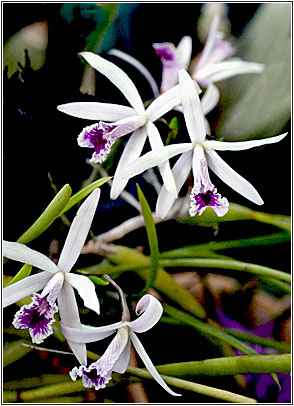 |
Registers
of the Occurrence:
In Brazil, Microlaelia lundii (Rchb.f) Chiron &
V. P. Castro has registers of occurrence in the Federal District
(Brasilia) and in the states of Goiás (GO), Minas Gerais (MG),
Mato Grosso do Sul (MS), Paraná (PR), São Paulo (SP) and, in
Argentina, in Missiones.
- For the states: DF, GO, MG and MT
Dungs & Pabst. Orchidaceae Brasilienses, 146;
- For the states of PR and SP and possibly going until the south
of the state of MG (not mention GO, MS and DF).
Francisco Miranda - Orquidário Vol 2(3) 46.51.1988;
- Confirmation of the occurrence in the state of Paraná
Eduardo Ferrarezi and Ricardo Faria, Orquidário 16(2):36.38.2002
- Missiones - Argentina by Correa, M. N., et al (http://mobot.mobot.org/cgi-bin/search_vast)
- Laelia lundii var. alba described by Lou Menezes
from a plant found by Antonio Schmidt, in Assis, state of São
Paulo. Synonyms:
Laelia regnellii Barb. Rodr.
Laelia reichenbachiana H. Wendl. & Kraenzl
Sophronitis lundii (Rchb. f. & Warm.) C. Van den
Berg & M.W. Chase
Laelia lundii Rchb. f.
|
Bibliography:
- The illustrated Encyclopedia of Orchids - Edited
by Alec Pridgeon;
- Orchidaceae Brasilienses - Dungs & Pabst.
- Francisco Miranda - Orquidário Vol 2(3) 46.51.1988
- Missouri Botanical Garden - http://mobot.mobot.org
- Orchids of Brazil - Jim & Barbara McQueen
|
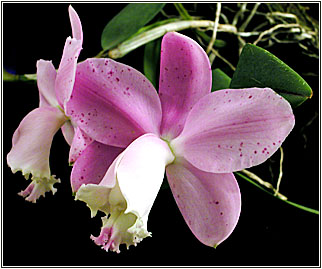 |
Cattleya
loddigesii Lindl.
This species is found in the states of Bahia, Espírito Santo,
Paraná, Rio de Janeiro mainly in Minas Gerais and São Paulo,
in the hillsides of the mountains covered by the Atlantic Forest,
in swampy and/or riparian areas, with heavy mist and temperate
climate between 500 and 900/1000m altitude. In general, it is
protected from the excessive luminosity and has high humid environment
during the summer and a dried winter. It can also occurs in
the summit of the hills, laying in the trunks of the trees receiving
a strong luminosity.
|
The
blooming period starts in the fall and goes through the springtime.
The flowers are 9cm diameter, exceptional quality plants, they
can reach 12cm.
It is a very close species to Cattleya harrisoniana Batem.
ex Lindl.
It forms many natural interspecific and intergeneric hybrids,
include second generation one:
Natural Interspecific Hybrids
x dolosa Rchb. f. - MG. (C. loddigesii Lindl.
x C. walkeriana Gardn.)
x hybrida Veitch - RJ x veitch - RJ (C. guttata
Lindl. x C. loddigesii Lindl.)
x o'brieniana Rolfe - MG (C. loddigesii Lindl.
x C. dolosa Rchb. f.)
x schroederaana Rchb. f. (or schroederiana Rchb.
f.) - MG (C. bicolor Lindl. x C. x dolosa Rchb.
f.)
x sororia Rchb. f. - sine loco, (C. bicolor Lindl.
x C. loddigesii Lindl.) (Synonym: C. x sanchesiana)
x valentine - ES (C. loddigesii Lindl. x C.
warneri Moore)
Natural Intergeneric Hybrids - Laeliocattleya
x amoena Hort. - RJ (x L. perrinii Lindl.)
x fredna (?) - SP (L. lundii Rchb. f.) [Microlaelia
lundi (Rchb.f) Chiron & V. P. Castro]
x lambari Pabst - MG [L. crispata (Thunb.) Miranda]
x leeana Rolfe - [L. pumila (Hook.) Rchb. f.]
Registers and occurrence of the hybrid Laeliocattleya
x fredna or Microcattleya cattleyioides (Rich.) V
P Castro & Chiron
Laeliocattleya x fredna (?) (Laelia lundii Rchb.
f. x Cattleya loddigesii Lindl.)
- Mention to the state of São Paulo, sob nº 916
Pabst & Dungs. Orchidaceae Brasilienses. 147.
- Not considered by Cassio Van den Berg & M. W. Chase
- Microcattleya cattleyioides (Rich.) V P Castro &
Chiron in Richardiana
Richardiana. II(1).26.2002
Synonyms
Epidendrum violaceum Lodd.
Cattleya arembergii Scheidw.
Occurrence:
- To the states of Espírito Santo, Rio de Janeiro, São
Paulo, Paraná and Minas Gerais.
Dungs & Pabst. Orchidaceae Brasilienses, 144;
Artificial Hybridizing
Cattleya loddigesii has been used in more than 5.500
crosses in 11 generations, forming interspecific hybrids such
as Brassocattleya, Brassolaeliocattleya, Cattleytonia,
Epicattleya, Epilaeliocattleya, Sophrocattleya,
Sophrolaeliocattleya; Schombocattleya (and/or
Myrmecocattleya) e Cattlychea (Prosthechea).
In cultivation
It is easier to be cultivated in temperate climate but it can
grows well in warmer places mainly if the nights are colder.
It should be protected from the excessive luminosity, the environment
should have high humidity during the hotter months when it should
be frequently watered. Reduce the watering during the winter
but be careful with the like cane stems, they wrinkled easily.
Improvement
Very appreciated plant, Cattleya loddigesii is one of
the most improved Brazilian species and has been submitted to
successive genetic improvements aiming to get rounder flowers
without a gap between the segments and also to enlarge the fan
colors. During the interview given to Orchid News (to be published
in the next edition), Álvaro Pessoa tells us a little about
the history of its improvement history. First, Adhemar Mannarini
selected special clones and worked with them. He introduced
in the market, during the 80 years, a quite expressive number
of varieties obtained in the laboratory working with striated,
punctata, punctassima, dark forms and so one. Other growers
have also worked with this species, such as Harusi Iwasita who
obtained high quality alba plants. Sebastião Nagase did an excellent
work getting bright colors from dark specimens, besides Nagkashima
and Aldomar Sander (the later in the south). In the state of
Rio de Janeiro, Siegweald Odebrecht got light colored plants
working with the clone ‘Martinelli'. Álvaro Pessoa himself
has already participated in this group working with plants coming
from Mannarini's laboratory.
Thus, nowadays, there is a great variety of color, from light
to dark pink, punctata, punctatissima and the very required,
alba variety.
|
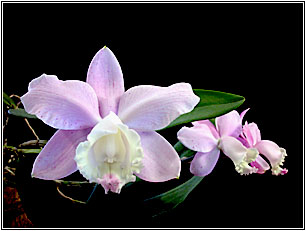
|
|
|
Habitat
photos : Fernando Gallerani
Orchid photos:
Sergio Araujo |
Any
kind of reproduction (print, digital or anyone) of any type
of material of this site: texts, layout, photos, images and
others - is
strictly forbidden without previous written permission of the
authors. All rights reserved. Any solicitation or information
by the e-mail: bo@sergioaraujo.com |
|
